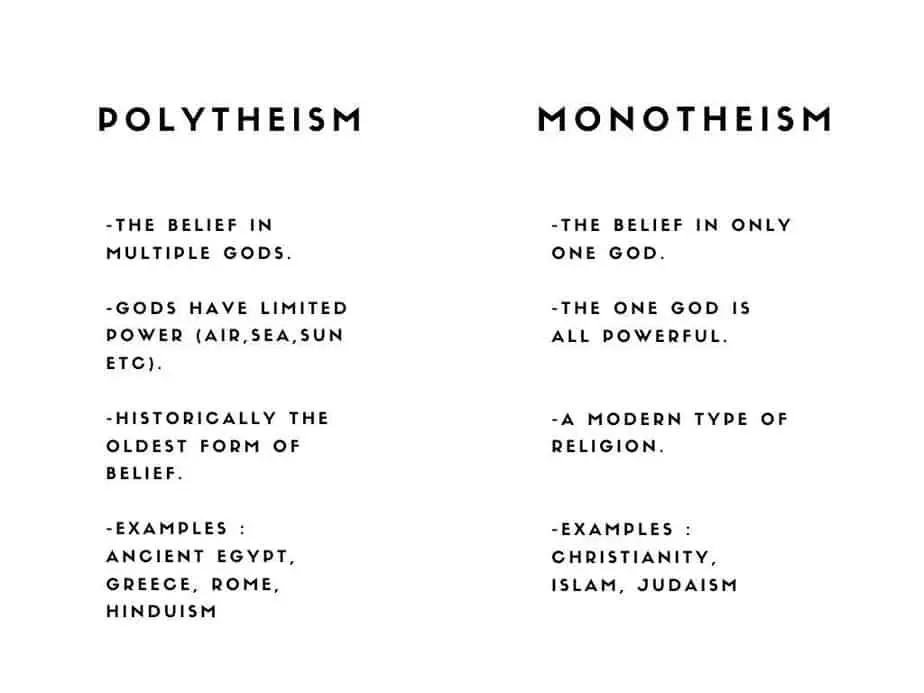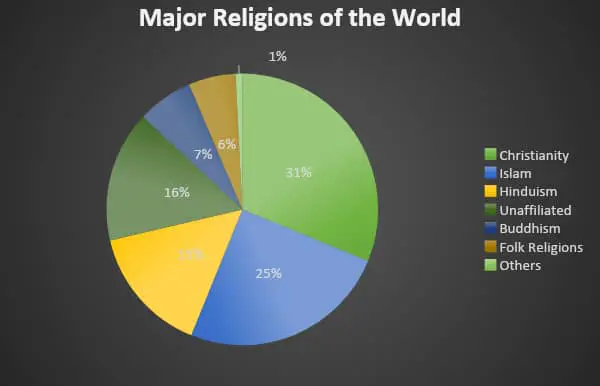
For most human beings, since their childhood, the image of God naturally develops in their minds and they are usually associated with their particular culture or religion. God is usually defined as a universal and impersonal being or existence but is perceived differently by different religions, cultures, beliefs, and philosophies.
Various concepts of God exist worldwide. Theists believe God is both the creator and sustainer of the universe, meanwhile, deists believe God is only the creator. Atheists believe in the absence of God, while agnostics believe God is unknown. Most religions have always been either monotheistic or polytheistic.
Comparison between Polytheism and Monotheism
The concept of god, singular or plural has existed for centuries all over the world in different religions, as a single entity or multiple deities as manifestations of a single entity. The unity or oneness of the divine in polytheistic groups Indian, Egyptian, Greek, etc.
Polytheism can be defined simply as the less polemical substitute for what was known as ‘idolatry’ or ‘paganism’ by monotheistic traditions. Monotheism constitutes a self-description of religions unlike that of polytheistic traditions. Polytheism never contradicts itself with monotheistic religions whereas monotheism asserts its identity by opposing itself to polytheism.
While polytheistic traditions believe in the concept of divine unity, they also worship a plethora of gods. Unity, to them, does not imply the worship of a singular god but the structure and coherence of the divine world, which is a pantheon, and not just an accumulation of different deities.

A chart of comparison between Polytheism and Monotheism
Polytheism
Polytheism is the doctrine of, belief in or worship of more than one god includes almost all the older religions like Hinduism, Taoism, Buddhism, etc. Anthropological evidence indicates that until the past few thousand years, most societies were polytheistic and these ancient polytheistic religions were without names such as those of Greek, Roman, Egyptian, Norse, etc. which generally followed pagan myths, rituals, and beliefs.
But in contemporary times, polytheistic religions are usually indigenous groups and tribal societies. In the United States, neo-paganism is a type of polytheism commonly associated with the new age beliefs and incorporates the elements from different types of polytheistic religions into their belief system.
People who believe in polytheistic religions might worship all gods equally, only worship some gods or place them in hierarchical structures. Often they focus on a supreme creator, for example, in Hinduism, there is a tendency to identify various gods as different aspects of the supreme creator. Sometimes gods are considered less important than some savior, higher goal or state, for example, in Buddhism. Other times a single god will appear more dominant than the others without overall supremacy, for example, Zeus from Greek mythology.
Besides gods, polytheistic cultures also believe in various ghostly and demonic forces as well as malevolent supernatural beings. The major forms of polytheistic powers, god and demons are natural forces and objects, vegetation, animal and human forms, and functional deities.
Different types of Polytheism
- Greco-Roman religion
The Greek traditions had considerable amounts of influence on the Roman by the time of the establishment of the Roman Empire and they somehow got fused. The Roman gods and goddesses were more serious, fierce, and warlike than their Greek counterparts, for example, Zeus became Jupiter, Hades became Pluto, Poseidon became Neptune, etc.
- Scandinavian, Celtic, Germanic, and Slavic mythologies
The three major Scandinavian gods were Odin, known as All-father, Thor the warrior god, and Freyr the fertility god was possibly the reflection of the Indo-European society’s tripartite division – priest, warrior, and cultivator. The sense of final doom of the gods along with the destruction of the world and its eventual recreation can be found in Norse mythology.
The stag-headed god Cernunnos of Celtic origin was important in iconography besides the wide variety of ancestral gods and goddesses of the fertility cults from the ancient Middle East.
The Slavic religions of Russia and Eastern Europe worship the high god who is not only the creator but also an atmospheric force. There are evidential similarities between the religions of the South Germanic mythologies and Northern European religions.
- Egypt and the Middle East
The Egyptian Pantheon of gods was presided over by the great gods, the sun god Ra and the sky goddess Nut. The pharaoh identified himself with Horus, the transformation of Ra. Middle Eastern religion is said to have stemmed from early Egyptian and Sumerian mythologies.
- Hinduism
Hinduism associates itself with the belief of incarnations or avatars. The trinity in Hinduism consists of Brahma, the creator; Vishnu, the preserver, and Shiva, the destroyer who represents the cyclical nature of birth, preservation, and destruction leading to regeneration. Hindu interpret many gods as the symbols of divine reality.
- Buddhism
In Mahayana Buddhism, the increased devotion to Buddha was elaborated along with the similar belief towards many celestial beings, for example, Amitabha, the Buddha of light, and Avalokiteshvara, the bodhisattva of compassion. However, in essence, they were all unified in the absolute or void.
- East Asian Religions
The ancestor worship and cult of heaven were woven into Confucianism in ancient China. Japanese culture was influenced by it and borrowed the main elements of Buddhism and Confucianism. Daoism is a model of imperial bureaucracy presided by the Jade Emperor.
Monotheism
Monotheism is the belief in a single all-powerful god or the oneness of God usually found in the new religions such as Christianity, Islam, Sikhism, Jewish, etc. God’s character and essence are believed to be not unique but also fundamentally different from all other beings and are conceived as the creator of the world and humanity. The God of monotheism is personal as exemplified in religions like Christianity, Islam, and Judaism.
The common religious language of monotheism is understandable because its conception differs in only one aspect from other religions, that is belief in God’s oneness as the Creator, Lord, King, or Father.
Different types of Monotheism
- Christianity
The Christian Bible which includes the New Testament has triadic liturgical formulas invoking the Trinity – God the Father, Son, and Holy Spirit. Roman Catholicism, Eastern Orthodoxy, and Protestantism acknowledge one God in three Persons but not of three gods but three of them essentially as one or dogmatic formulation that is three Persons and one substance.
- Islam
Monotheism has been interpreted most consequentially and literally in Islam. The profession of faith states unambiguously and clearly that no other God exists besides Allah. Islam knows no greater sin than the attribution of partners to Allah or polytheism.
- Judaism and Religion of Israel
Passionate importance is given to Yahweh as the one true god and similarly rejected to any other gods. The prophets stressed the ethical aspect that was as important as the exclusiveness of the one god.
Major Religions of the World
The followers of major religious groups of the world mainly include:
- Christianity – 31.11 %
- Islam – 24.9 %
- Nonreligious – 15.58 %
- Hinduism – 15.16 %
- Buddhism – 5.06 %
- Chinese traditional religion – 5 %
- Ethnic religions – 3 %
- African traditional religions – 1.2 %
- Sikhism – 0.30 %
- Spiritism – 0.19 %
- Judaism – 0.18 %
- Baha’i – 0.07 %
- Jainism – 0.05 %
- Shinto – 0.05 %
- Cao Dai – 0.05 %
- Zoroastrianism – 0.03 %
- Tenrikyo – 0.02 %
- Animism – 0.02 %
- Neo-Paganism – 0.01 %
- Unitarian Universalism – 0.01 %
- Rastafari – 0.007 %

The major religions of the world in the percentage
Conclusion
There are thousands of religions in our world while some have perished with time. The God(s), minor deities, and other divine beings belonging only to the major religions of the world sum up to tens of thousands and even more, excluding the existence of smaller religious groups. It is not possible to count the number of gods there are around the world from every religion, being practiced or extinct.
Frequently Asked Questions
- Which god should one follow?
We have the free will to decide what to believe in and what to not. To believe in a God(s) is entirely up to the individual’s decision.
- Which religion should one follow?
Same as the previous answer, it is one’s free will. But there are exceptions, for example, a person following Hinduism is born as a Hindu.
- Is Monotheism secondary to Polytheism?
There have been multiple arguments on this topic. Some believe monotheism to have existed in ancient times while others argue it has originated only in the last couple of thousand years.
